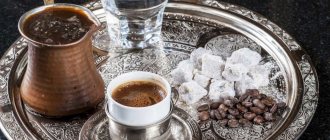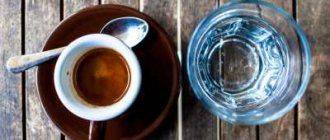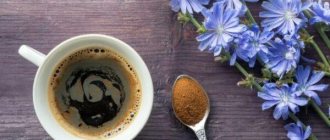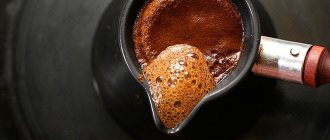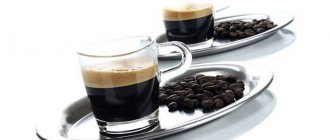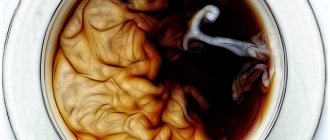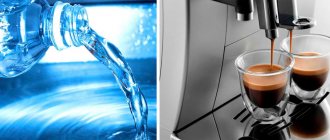About 1.6 billion cups of coffee are drunk per day worldwide. Some studies claim that this statistic is incorrect, and daily consumption of coffee drinks is approaching 2.7 billion cups, which amounts to at least 500 billion coffee drinks per year.
There are many variations on the coffee theme: black (espresso, Americano), with milk (cappuccino, latte), frosted with ice cream, Viennese with whipped cream, Greek frappe with ice, brewed on sand with spices, and so on.
The above coffee preparation options, in turn, are also divided into subtypes, for example, depending on the serving size, espresso (approximately 30 ml) can turn into ristretto (15-20 ml) or lungo (60 ml).
Most coffee shops and restaurants serve water with coffee. But not everyone understands why this happens. It is not necessary to dilute the drink with water; it seems like it should be washed down too. Then why is it needed and at what point should it be used? This article is devoted to these issues.
All self-respecting establishments serve water to:
- any hot brewed black coffee,
- espresso,
- macchiato,
- Viennese coffee,
- Turkish coffee,
- coffee with egg yolks.
Water after coffee - why?
The European tradition of serving a glass of water with coffee originated in Vienna, around the 19th century, and absolutely did not involve the use of this water.
The fact is that Viennese coffee, which was very loved by European aristocrats of that time, adds whipped cream, which forms a dense foam on the surface of the drink. After stirring the drink, the noble ladies were faced with the question of a dirty spoon: you can’t put it on a saucer, etiquette doesn’t dictate it, and you can’t even lick it, it looks terribly inelegant.
A glass of water solved this problem: the spoon was dipped into the water, and then they calmly continued to enjoy the coffee drink.
You can learn more about nutrition rules and the principles of forming a reasonable diet in dietetics courses.
How do they drink espresso with water in different countries?
People all over the world love to drink coffee and start their mornings with it. It not only makes you wake up, but also sets the mood for the whole day. Still, some countries retain traditions and coffee drinking habits that are unique to them. For example, in Greece or Turkey, coffee brewed in a Turk is a favorite; a glass of cold water is always served with it. In many European countries, the invigorating drink is consumed mainly after lunch. Let's study some local features of coffee drinking in different countries.
In Italy
Residents of Italy drink the invigorating drink in a special way:
- Italians do not drink coffee from large mugs in the morning in the American style; they are more accustomed to drinking espresso from small porcelain cups after a heavy lunch or dinner.
- They believe that espresso helps digest food, so they drink it after meals. Cappuccino or other options with milk can cause heaviness in the stomach and indigestion.
- Italians do not drink espresso on the go; they prefer to sit at the bar or in a cozy coffee shop, in a relaxed state after a meal.
- They drink it exclusively black and without sugar, so as not to interrupt the bright aroma and noble sourness.
Still, Italians have some taste options - in a cafe you can ask for cool coffee, it will be served in a glass, or café correto - coffee with a small amount of strong alcohol.
In France
In this European country, the word espresso is considered synonymous with coffee. In France, during meals at any time of the day, there is a carafe of water, everyone pours themselves as much as they need. If a client orders espresso in a cafe, they always bring him a large glass of water. The French believe that water should be drunk before coffee, not after it.
Sometimes the French order coffee with a small amount of liqueur, which they prefer to drink in a street cafe with a cigarette in hand.
In Greece
The hallmark of Greece is considered to be frappe - a cold coffee cocktail made from instant coffee. One of the brewed analogues of frappe here is espresso, which is also served cold. This drink is popular in Greece, both in the summer heat and in cool weather. To prepare it, you need to put a few pieces of ice and sugar to taste in a tall glass, then pour espresso in a slow stream.
In Arab countries
The culture of coffee consumption itself came from Arab countries, where the entire fruit of the tree was originally used. Later, the Arabs began to extract extract from coffee beans, grind them and process them with animal fat for further consumption. A few more centuries later, they began the practice of roasting and grinding coffee.
Today in Arab countries, espresso, like other types of coffee, is prepared with the addition of a whole bouquet of spices - cinnamon, cardamom, cloves, saffron and others. To soften the tart taste of coffee a little, it is served with water and dried fruits. In some countries, spices are roasted along with coffee beans and brewed to create a unique, aromatic drink.
Why water for coffee?
There, in Europe, the habit of drinking coffee with water took root. In the 19th-20th centuries, and even now, Europeans spent a lot of time socializing, reading books and discussing news in coffee shops. People were supposed to relax by drinking coffee, but not all elderly visitors to the establishment could treat themselves to several cups of coffee in a row due to health reasons. Therefore, having ordered one, it was alternated with sips of water, which made it possible to calmly communicate for the rest of the evening without overusing caffeine.
The tradition took root in all European countries, and later spread throughout the world.
Traditions and history
The birthplace of this invigorating drink is Italy, and the Italians’ love for coffee is limitless. For most residents, coffee is considered a way of life, and the coffee ritual determines the daily routine and even the rhythm of life. There is a tradition here of drinking certain drinks at set times of the day. For example, cappuccino can be served only in the morning, and espresso - strictly after lunch and dinner.
Reference! The word "espresso" can be translated from Italian as "quick, quick, compressed or compressed." The dictionary also gives the meaning of "expressive", which means that in the case of a drink it should sound like "expressive coffee". Perhaps the inventors of this drink wanted to designate it as “expressive and unique.”
The tradition of making espresso has not changed for many years, since the method was invented by the Milanese engineer Luigi Bezzera. He patented his invention as a coffee machine and prepared compressed coffee, that is, he passed hot but not boiling water through a filter with ground coffee beans. This machine was based on mechanical action and was driven by a trigger mechanism. For almost half a century, the technology for making espresso did not change and coffee machines worked according to the original principle. The main purpose of such a device was to save time on preparing coffee during workers' rest breaks.
But the pressure in the apparatus was created using steam, which affected the taste of the drink - it became bitter. The Italians call the birthday of modern espresso September 5, 1938, when Achille Gaggia invented a coffee maker with a rotating screw piston that forcefully pushed water through the coffee, excluding the participation of steam. Not stopping there, the inventor moved on and improved the mechanism of the device. He even registered his own company for the production of espresso coffee machines, which bear his name - Gaggia. They use steam only to froth the milk, but not to prepare the drink. The coffee preparation time was reduced, and the coffee itself turned out thick with a thick creamy foam.
Already in 1953, Gaggia coffee machines participated in an international exhibition and became increasingly popular on the world market. They made a real revolution in the coffee industry and showed the whole world what real Italian espresso means. In 1961, Faema replaced the manual lever with an electric pump, which was able to maintain the desired level of pressure in the machine. Nowadays, coffee machines are configured for a full automatic espresso preparation cycle, starting from grinding the beans and ending with setting the necessary parameters.
Why do they serve water with coffee?
The water that complements a cup of coffee performs a number of functions:
- Receptor cleansing.
Coffee is a rich and dense drink. Due to these properties, taste buds quickly “turn off” and stop perceiving subtle coffee notes. Alternating a sip of coffee with a sip of liquid helps restore sensitivity.
- Effect on pressure.
It is common knowledge that coffee increases blood pressure. Water consumed in parallel with coffee reduces the concentration of caffeine in the body, preventing sudden surges in blood pressure.
- Enamel whitening.
Coffee drinks contribute to the formation of plaque. To prevent the pigment from settling on your teeth, you need to drink your coffee with water.
- Help the stomach.
Due to the hydrochloric acid produced by the stomach in response to coffee entering the body, this drink should not be consumed in its pure form. Water regulates the production of hydrochloric acid, having a beneficial effect on the gastrointestinal tract and preventing heartburn.
Should it be consumed before or after a coffee drink?
In order for the drink to benefit the body, give a unique sensation to the receptors and not leave a bad aftertaste, you need to drink a few sips of water before, during and after drinking espresso. Each of these actions has its own logical explanation.
Drinking water before drinking coffee is necessary in order to eliminate the remnants of previous food on the taste buds and prepare them to perceive coffee notes. Then a person will be able to enjoy the whole palette of sensations and retain a pleasant aftertaste for a long time.
During administration, you need to alternate between the drink and H2O . Even after the first sips of espresso, you cannot fully feel its taste and aroma. Therefore, to sharpen the sensations, coffee lovers are advised to drink some water.
Then the next sips will again become rich in sensation, and the invigorating property will appear even more intensely. Water also dilutes the cloying or sourness if it is present in the drink and relieves the feeling of thirst after a while.
You need to drink water (about 200 ml) after coffee about 15-20 minutes so as not to deprive yourself of the coffee aftertaste. Reasons for drinking water after espresso:
Teeth protection .
The drink leaves a yellow coating on the enamel, which is absorbed into it and spoils the whiteness of the teeth. Dentists advise drinking a little water after espresso to wash away the coffee pigment and prevent it from being absorbed. Otherwise, a subsequent negative effect on the enamel will be ensured.- Cardiovascular protection . If you drink a little cool, clean water immediately after drinking the drink, the drinks will mix in the stomach, and the effect of coffee on the heart and blood vessels will be minimized. Water protects the cardiovascular system from overload, regulates heart rate and prevents sudden increases in heart or blood pressure.
- Protection against vasoconstriction of the kidneys . If a person suffers from kidney disease, he simply needs to drink a glass of water to prevent narrowing of the renal vessels and prevent the occurrence of aching pain.
- Protection against dehydration . Having diuretic properties, coffee can have a bad effect on human mucous tissue and skin. By drinking water after espresso, a person prevents excess fluid loss.
- Eliminating aftertaste . To get rid of the cloying bitter or sour feeling in your mouth, you need to drink a glass of water.
Why a glass of water with coffee?
Bottled, boiled or spring water at 10-15°C is best suited for coffee drinks (if the region is hot, then up to 20°C is allowed). It should not contain unnecessary odors (for example, bleach) and be too cold, because tooth enamel is very susceptible to sudden temperature changes.
If desired, you can add citrus fruits or mint to the water. However, you should be careful with the dosage, because obvious side flavors will not allow you to fully experience the taste of coffee.
What should H2O be?
Cold and clean water is used for supply, but does not contain chlorine and is not distilled. Its temperature should be in the range from 10 to 15 °C.
Do not add ice cubes, sugar or sweeteners to the water. It is also not advisable to mix it with lemon juice, fruit juice or herbal decoction.
Mixing with juice or decoction is allowed only if the drink is prepared according to the original recipe , and such a drink serves to enhance or emphasize the taste sensations.
Tradition or intuition?
It is believed that the first people to be served coffee with water were the medieval rulers of the Arabian Peninsula. A portion of the foamy drink usually completed a hearty meal, consisting of a series of dishes rich in spices.
Cold water remained the only means capable of restoring the perception of taste, dulled by spices, and emphasizing the strength of the then rare decoction.
But it is quite possible that such a need is actually dictated... by the subconscious.
The inhabitants of the desert East, sweltering from the heat, who, however, did not refuse to cheer up with strong hot coffee, alternated each sip of it with cold water, cooling down somewhat and intuitively protecting their body from dehydration caused by it and the heat.
There is also a version that a glass of water was first brought along with a cup of coffee in Turkey. They use it differently here.
Residents of this country, not wanting to save time with the machine “quick-fire” that is familiar to Europeans, prepare a decoction of coffee beans traditionally - in a cezve on the sand and consume it separately from food.
Before “drinking” into the contents of a small cup with an oriental pattern, residents of Turkey neutralize the taste of the previously eaten food by drinking water first, and believe that they only want to wash down hastily prepared, tasteless coffee with water.
Requirements for dishes
How to drink coffee with water correctly: there are two options - both are correct. The first is to drink liquid first, then slowly espresso. The advantage of this method is that the body receives a sufficient amount of moisture, and it will not suffer from dehydration.
The second is to alternate espresso and water. This method is preferred by gourmets who constantly try new varieties of grains, trying to capture all the shades of taste.
What kind of cups are needed for espresso: small, with thick walls to keep the temperature longer. Usually they are heated from the top of the coffee machine - if you pour them into a cold container, the drink will no longer be hot.
In the East, it is customary to pour coffee into thin-walled porcelain. By and large, what kind of dishes to use depends on the establishment itself.
